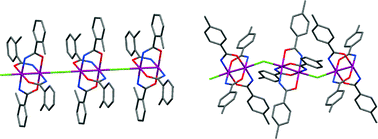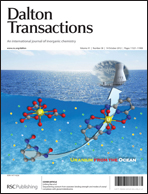Solvothermal and microwave assisted synthesis were used as green and very useful alternative methods to obtain new chloridotetraamidatodiruthenium compounds, [Ru2Cl(μ-NHOCR)4]n [R = Me-o-C6H4 (1), Me-m-C6H4 (2), Me-p-C6H4 (3)]. The analogous tetracarboxylato complexes [Ru2Cl(μ-O2CR)4]n [R = Me-o-C6H4 (4), Me-m-C6H4 (5), Me-p-C6H4 (6)] have also been obtained. These synthetic methods allow the use of greener solvents like water or ethanol. Moreover, solvothermal synthesis permits the direct crystallization of the desired complexes, which are extremely insoluble in common solvents, during the synthetic process. Therefore, the crystal structure of all of them has been established using single crystal X-ray diffraction. Complex 1 shows a Ru–Cl–Ru angle of 180° and constitutes the first example of a chloridotetraamidatodiruthenium derivative displaying linear chains in the solid state. In contrast, complexes 2·0.5EtOH, and 3–6 show polymeric arrangements with the diruthenium units linked by chloride ligands, forming zigzag chains with Ru–Cl–Ru angles ranging between 117.03(6) and 121.45(3)°. All of the complexes show magnetic moments at room temperature corresponding to three unpaired electrons in agreement with the σ2π4δ2(π*δ*)3 ground-state configuration, which indicates a similar magnetic behaviour in amidato and carboxylato derivatives. In the linear arrangement of complex 1 there is a better magnetic communication between diruthenium units (antiferromagnetic coupling, zJ = −10.5 or −8.7 cm−1) than the one observed in the zigzag 2–6 complexes (zJ = −1.23 to −5.75 cm−1).

You have access to this article
 Please wait while we load your content...
Something went wrong. Try again?
Please wait while we load your content...
Something went wrong. Try again?


 Please wait while we load your content...
Please wait while we load your content...